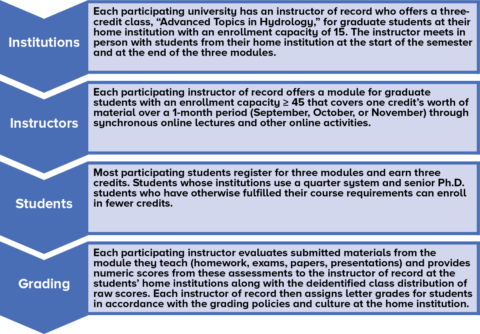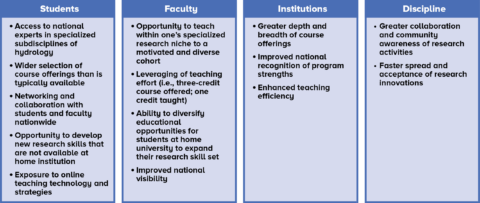The COVID-19 pandemic has upended teaching, research, and lives across academia for months, but it may also present opportunities to enact lasting, positive change on higher education. Faculty, researchers, and students have adapted amid the challenges, adjusting research plans and gaining experience with online instruction. With this newly developed flexibility and with university financial outlooks looking precarious, now may be the time for institutions to join forces and pool resources. One productive avenue would be to increase collaborative graduate student training. If structured properly, universities could efficiently and cost-effectively offer a wider array of courses covering the latest techniques, theories, and research findings taught by the very experts who are developing the science.
During their training, graduate students, particularly Ph.D. students, focus on increasingly specialized subdisciplines where they can push frontiers of knowledge. My field of expertise, the hydrologic sciences, is highly interdisciplinary, drawing on work in geoscience, engineering, agronomy, soil science, physics, chemistry, biology, meteorology, computational sciences, and forestry. Addressing the research questions and societal challenges facing hydrologists increasingly requires both specialized technical knowledge and collaboration. The newest and best tools that students need to pursue their research are also becoming increasingly specialized and are not typically taught in core curricula. But as science advances, faculty cannot continue expanding their teaching portfolios, and universities cannot continue hiring at a pace that matches this ever-increasing growth of specialization.
While on sabbatical in 2015, I cotaught a 2-week ecohydrology course at the Universidad Nacional de San Luis in Argentina, an experience that opened my eyes to the benefits of specialized, collaborative graduate education. Pooling the best and brightest Ph.D. students from peer institutions across the region to live and study together enabled sharing of very different individual perspectives and experiences while learning about the most recent ecohydrologic theory, modeling, and field methods. The free exchange of ideas among those students, all of whom were deeply invested in niche subdisciplines, was distinct from what I had previously experienced as either instructor or student. They challenged each other, learned from each other, and discovered where knowledge gaps existed.
In hydrology, collaborative research is the norm. Approximately half of National Science Foundation (NSF) funding for the Hydrologic Sciences supports multi-institution collaborations. Yet collaborative training of graduate students across universities remains rare. Why is that? Why aren’t collaborative frameworks like those I observed in Argentina, where students earn university credit, common in the United States?
There are some obvious barriers to that model. For students, it requires travel that incurs costs such as putting student research on hold, and differing academic calendars can cause scheduling conflicts. For institutions, there isn’t a clear mechanism to share costs and revenue, and liability and housing issues can be a concern. For faculty coordinators, initiating collaborations among universities can be met with a host of other barriers that may appear to outweigh likely benefits to them as individuals.
To increase graduate student access to highly specialized courses in the hydrologic sciences and capitalize on the benefits of collaborative training, colleagues and I developed, piloted, and evaluated a flexible framework that reduces the risks, costs, and barriers to faculty, student, and university participation. We believe the pilot program offers a sustainable model for collaborative graduate education in the hydrologic sciences that could be readily transferred to other disciplines.
A Virtual University Framework

Through the NSF-sponsored Consortium of Universities for the Advancement of Hydrologic Science, Inc. (CUAHSI), we developed the CUAHSI Virtual University (CVU) as an interinstitutional community of graduate students and educators in the hydrologic sciences. During the 2017, 2018, and 2019 fall semesters, a varying mix of six to nine faculty participated from institutions shown in Figure 1 as well as from the University at Buffalo; the University of California, Santa Barbara; the University of Delaware; and Kent State University.
The framework of CVU is based on reciprocity: For students at an institution to participate, at least one instructor at that institution must offer a one-credit online module for students from other participating institutions. Each student selects their own combination of modules to make up a three-credit course at their home institution. No transfer of tuition dollars occurs, however. Roles and responsibilities of participating institutions, instructors, and students are outlined in Figure 2. As in a traditional classroom, the online lectures and discussions are conducted synchronously, facilitating face-to-face, real-time interactions among students and the instructor. Each module covers a highly specialized topic that is unlikely to be covered at most institutions, such as hydrologic applications of drone-based remote sensing (Figure 1). CUAHSI facilitates CVU by recruiting and organizing instructors, advertising the program, hosting the learning management system and Web conferencing software, registering students for individual modules, and addressing technical issues that arise.

There are different incentives and potential benefits of CVU for students, faculty, institutions, and the broader hydrologic community, as outlined in Figure 3, although for everyone there is little additional cost or time commitment beyond their regular duties. Students are already expected to take courses and pay tuition (or have it paid on their behalf), and faculty workloads include teaching, for which they are compensated by their employing university. Universities are expected to offer a modern, robust curriculum to support graduate degree programs, which CVU helps address by broadening course offerings beyond the expertise of each institution’s faculty and by facilitating efficient use of faculty, who offer three-credit courses while providing direct instruction for one-credit modules.

Successful Outcomes
In 2017, we evaluated CVU using semistructured interviews of faculty before and after module instruction. And students were surveyed each year at the start of the semester to document their expectations, after each module so they could provide instructor feedback, and at the conclusion of the semester to evaluate the effectiveness of the educational framework.
Students made connections through CVU that have resulted in leads on potential postdoctoral research and tenure-track faculty positions.
The evaluations revealed that many aspects of the program were successful: 100% of faculty in 2017 stated that they would recommend this experience to others, and 96%, 89%, and 96% of students reported the same in the first, second, and third years, respectively, of the pilot program. The surveys also indicated that CVU accelerated uptake of research advancements among the students, with 67%, 77%, and 89% of students in 2017, 2018, and 2019, respectively, stating they would use or might use their newly acquired knowledge in their thesis, dissertation, or research publications.
Outcomes not captured in the surveys also had substantial impacts on individual participants. For example, a former CVU student and recent Ph.D. graduate contacted me with ideas related to our virtual class that led to a collaborative research proposal and, ultimately, to her winning her first federally funded research grant. Other students made connections through CVU that have resulted in leads on potential postdoctoral research and tenure-track faculty positions. Furthermore, all students and faculty gained experience collaborating virtually, which in retrospect proved extraordinarily beneficial in easing the transition to virtual teaching, learning, and collaboration during the current pandemic.
Room for Improvement
The synchronous model poses challenges in effective implementation of the program because it requires simultaneous participation of students and faculty from many institutions. However, we deemed it worthwhile because it supports our goal of facilitating student and faculty networking in the hydrologic research community. We found that the logistical and scheduling issues were of less concern than anticipated, partially because graduate students tend to have relatively flexible schedules and because the students could select from among other modules if they had a time conflict with one. This is a characteristic that will be further enhanced as the program grows and more modules are offered.
A community of educators developed during CVU in which instructors shared strategies that did or did not work in their experiences.
The surveys and interviews also identified several areas for improvement. Most participating faculty and students had little to no prior experience with online education and expressed apprehension about using the technology effectively. Participants were therefore understanding of technical problems that occurred and occasionally suggested ways to improve virtual interactions, even if only to report glitches such as muted mics, failed screen sharing, or fonts used in programing demos that were too small.
Roughly two thirds of student respondents felt that too much material was covered in the 1-month modules, and 83% of instructors reported feeling rushed in their instruction. Undoubtedly, the instructors’ enthusiasm to promote their areas of expertise contributed to this outcome. It could be overcome through tighter focusing of topics and better scheduling of course activities.
A community of educators developed during CVU in which instructors shared strategies that did or did not work in their experiences. In response to this positive outcome, subsequent offerings of CVU will do the following:
- continue fostering educator communities to support instructors and facilitate exchange of teaching techniques
- develop a series of best practices based on past instructor and student feedback
- provide guidance to faculty on expectations and workloads to improve consistency across modules
The Future of Collaborative Graduate Training
In a June article in the Chronicle of Higher Education, John Villasenor made the case that universities should pool teaching resources to improve access and save money in response to the COVID-19 pandemic. CVU does that by attracting students from across the country to take specialized classes that would certainly be underenrolled and financially inefficient if offered individually on most campuses. Our framework avoids barriers associated with interinstitutional tuition reimbursement by embracing a system of reciprocity in which instructors must offer modules to provide students at their university the opportunity to enroll in CVU, and we aim for approximate parity in the number of class seats available to each university.
Our pilot of CVU convinced us that the benefits of this structure for collaborative graduate training outweighed the challenges.
Our pilot of CVU convinced us that the benefits of this structure for collaborative graduate training outweighed the challenges, most of which were associated with apprehensions about navigating the online instruction environment. And although students also acknowledged logistical and learning challenges in the online environment, they indicated in surveys that one forward looking reason they participated in CVU was to gain familiarity with online courses, which they expect to teach throughout their career. That time of increased online teaching may have arrived sooner than expected.
Under pandemic conditions, the technology barriers identified by participants have been substantially diminished. We thus believe now is an opportune time to expand CVU and programs like it. With growth and continued improvement, this framework can transform the way we train graduate students and disseminate the latest research findings across the hydrology community. We also suggest the CVU model could work well in other disciplines within the geosciences and beyond, particularly those encompassing specialized subdisciplines that are not well represented in instruction at all universities.
Acknowledgments
This material is based upon work supported by the National Science Foundation under grants 1700983, 1849458, 1855996, and 2028737 and an Educational Innovation Award by the College of Engineering at the University of Wisconsin–Madison. This work would not be possible without CVU co-instructors who contributed to development of CVU and the ideas presented here: Christopher Lowry, Christina Tague, Holly Michael, David Hyndman, Anthony Kendall, Scott Tyler, David Tarboton, Adam Ward, Jessica Lundquist, Samuel Smidt, Hilary McMillan, Hans-Peter Marshall, Anne Jefferson, and Dominick Ciruzzi. In addition, I thank Mary Thompson, Ainsley Brown, and Liz Tran for their assistance in managing and evaluating CVU.
Author Information
Steven P. Loheide II ([email protected]), Department of Civil and Environmental Engineering, University of Wisconsin–Madison
Citation:
Loheide, S. P., II (2020), Collaborative graduate student training in a virtual world, Eos, 101, https://doi.org/10.1029/2020EO152183. Published on 04 December 2020.
Text © 2020. The authors. CC BY-NC-ND 3.0
Except where otherwise noted, images are subject to copyright. Any reuse without express permission from the copyright owner is prohibited.


